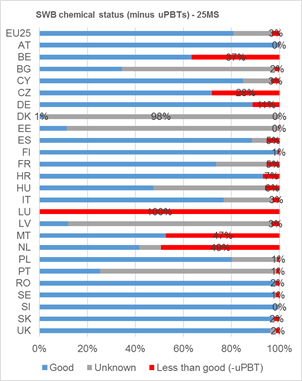Post a comment on the text below
There are substantial differences between Member States. Some report that over 90 % of their surface water bodies are in good chemical status, while others report that fewer than 10 % are in good chemical status (Figure 3.2). In addition, the proportion with status reported as “unknown” differs widely between Member States. For several Member States there is a marked change in the proportion failing to achieve good chemical status when the water bodies failing due to uPBTs are omitted.
Figure 3.2: Chemical status of all surface water bodies, with all priority substances (on left) and without uPBTs (on right)


Note: For some surface water bodies in Poland (1265 WBs) and Italy (265 WBs), there is no information on the priority substances causing failure and it is therefore not possible to identify if the failure is caused by uPBTs or other priority substances.
Source: Preliminary results based on WISE-SoW database including data from 25 Member States (EU28 except Greece, Ireland and Lithuania).
Some variation between Member States might be expected, owing to differences e.g. in population density, industry or geography, but such extreme variation needs to be understood. Member States have interpreted information in different ways, leading to some variation. For example, some Member States applied the revised – generally stricter - EQS set out in the 2013 amendment to the Priority Substances Directive (LU, NL, SE) while most countries used those from the 2008 version of the Directive. However, the major contribution to variability seems to arise from the approach taken to monitoring, modelling and extrapolation of results, and from the choice of monitoring matrix – water, sediment or biota (e.g. fish). Some countries extrapolated failure of the standard at monitoring sites to all water bodies, while others reported failure only where failure was confirmed (Table 3.1). Typically, measurements of mercury in biota extrapolated to all similar waterbodies lead to widespread failure to meet the EQS.
Luxembourg failed to achieve good chemical status in any of its surface water bodies, owing to application of the 2013 EQS for fluoranthene, while neighbouring countries applied the 2008 standard.
You cannot post comments to this consultation because you are not authenticated. Please log in.



Previous comments
“Luxembourg failed to achieve good chemical status in any of its surface water bodies, owing to application of the 2013 EQS for fluoranthene, while neighbouring countries applied the 2008 standard.” Please add: In The Netherlands about 50% of the surface water bodies failed for the 2013 EQS for fluoranthene. This indicates that the graph underestimates the challenge to reach the chemical status in the next cycle, in case the 2013 EQS standards have not been applied.
In the legend ”less than good” should be replaced by ”failing to acheive good”.
In order to avoid any confusion, it would be helpful to indicate which EQS have been used for this evaluation.
For Luxembourg, we made 4 assessements of the chemical status: one on the basis of directive 2008/105/EC (with and without uPBTS) and another on the basis of directive 2013/39/UE (with and without uPBTS). The results of these 4 assessements are described in chapter 6 of the 2nd RBMP. The results shown on the right are those for directive 2013/39/UE.
"For example, some Member States applied the revised – generally stricter - EQS set out in the 2013 amendment to the Priority Substances Directive (LU, NL, SE) while most countries used those from the 2008 version of the Directive." please delete Luxembourg from the enumeration list. We made 4 assessements of the chemical status: one on the basis of directive 2008/105/EC (with and without uPBTS) and another on the basis of directive 2013/39/UE (with and without uPBTS). The results of these 4 assessements are described in chapter 6 of the 2nd RBMP.
The figure leaves a wrong impression as the methods for measurements applied in the Member States can't be compared. In this instance, the figure is closely linked to the tabled below which should at least be clarified in the text.
"Member States have interpreted information in different ways, leading to some variation. "
Important notice.
Figure 3.2 is depicting incorrect information for Malta. Malta reported failure of chemical status in surface waters (9 water bodies) due to exceedance of mercury. If Mercury is omitted, all water bodies are in good chemical status (19 water bodies). The dashboard at the following link is showing the correct scenario.
https://tableau.discomap.eea.europa.eu/t/Wateronline/views/WISE_SOW_SWB_SWPrioritySubstanceWithoutUPBT/Country?:embed=y&:showAppBanner=false&:showShareOptions=true&:display_count=no&:showVizHome=no
"Member States have interpreted information in different ways, leading to some variation. For example, some Member States applied the revised – generally stricter - EQS set out in the 2013 amendment to the Priority Substances Directive (LU, NL, SE) while most countries used those from the 2008 version of the Directive."
The report indicates that some MS used new EQSs whereas some do not. We acknowledge this indication; however, we believe more detail would be beneficial here for this to be an even comparison. Also, other possibilities (e.g. use/lack of use of bioavailability normalization) should be further considered. The inclusion of a figure similar to Fig. 3.1 to show chemical status with and without bioavailability normalization would be mostly helpful and welcome.
"Typically, measurements of mercury in biota extrapolated to all similar waterbodies lead to widespread failure to meet the EQS."
We agree with the need for improving the assessment of compliance with the mercury EQS. Is this something that could be developed within the EEA or the Commission’s assessment, or later on?
Referring to our general comments, with regard to the assessment of compliance with the mercury EQS, we would like to suggest that biological background for mercury should be taken into consideration.
In figure 3.2 we suggest to add information to the note under the figure: Member states have used different standards for chemical status.
Figure 3.2: Please refer to our previous comment on chemical data and confidence level (from 'Executive Summary').